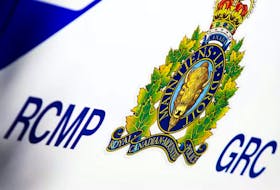PARADISE, N.L. — Andrew Waterman
The Telegram
It was a scream loud enough that Holly Abbott’s neighbour in the newly developed area of Magee Drive in Paradise could hear it.
“Last night, (our dog) Miley, when she went out, she stopped, and she started to bark pretty seriously,” Abbott said earlier this week. “I just let out a scream, balling at her, so she’d stop and wouldn’t run. She just froze (and) I got her in.”
Being new, the Abbotts' backyard is not yet fenced in, and behind them is all trees. Miley wasn’t yet on her leash and Abbott feared she’d run toward whatever was making her bark, which she assumed was a cat or dog from a neighbouring yard.
She hadn’t heard the other growl, pointed out to her by a friend afterward. And it wasn’t until her husband, Ryan, ran into another room to look out the back window that they realized what Miley, her small Yorkshire terrier and Bichon Frise mix, had been barking at.
“He said, ‘Oh my god, come here,’ (but by) the time I got there the coyote had actually gone in through the trees. … You could see the tracks where it came down (into our backyard),” she said.
Abbott says since moving into their house in July there have been times when they’ve heard "howls" off in the distance.
“But that’s the first that we’ve actually seen them (a coyote) come out.”
According to the provincial Department of Fisheries and Land Resources website, coyotes arrived in Newfoundland in the mid-1980s, with the first confirmed sighting being a coyote pup hit by a car in Deer Lake in 1987.
Now considered established in Newfoundland and Labrador, the member of the carnivorous Canidae family — which includes wolves, foxes and dogs — has made much of North America its home over the past 100 years, because of its ability to adapt to different habitats and its willingness to eat anything available.
There was also a report of a “wolf-like dog” coming over the ice toward the Port au Port Peninsula on the west coast in the spring of 1985.
Coyotes have since been confirmed in most parts of Newfoundland, as well as central and southern Labrador.
Shane Mahoney, CEO and president of Conservation Visions Inc., says just as significant snowfall and storms can affect humans, they also affect wildlife.
“Wild animals respond to their environments in very immediate ways,” Mahoney said. “Winter time, which is a time of high stress for many animals, there is an opportunity for more ease of movement or, in other circumstances, even protection from predators by coming into places frequented by human beings.”
Conservation Visions Inc. is a St. John’s-based wildlife conservation policy and advocacy organization that does work internationally, Mahoney says.
As a research biologist, Mahoney has published extensively on woodland caribou, moose, black bears, and the predator and prey relationships between the black bear, coyote, lynx and the woodland caribou. He's been working in this area for over 30 years.
Mahoney says a good example of the impact of a heavy snowfall on wildlife in Newfoundland would be interactions between snowmobilers and moose, particularly later in the year.
“The moose will get on this packed-down trailway of snow … and is very reluctant, sometimes belligerently so, to get off that track and get stuck in the deep snow which causes them so much difficulty,” he says.
“Similarly, if (an animal) sees an advantage for any reason … it is possible that wildlife will come to those places, even overcoming their normal reluctance to be around people to do so.”
Once in these areas, the animals may become trapped and unable to find a way back.
As for coyotes, if they have an opportunity to kill and eat a small animal, whether domestic or wild, they will.
“That’s what they do, that’s how they operate,” Mahoney said. “But let’s put this in perspective. Newfoundland does not have a huge, high density population of coyotes.”
Mahoney says years of intense, well-publicized research demonstrates this.
“But we do have them and they sometimes come close to people, and undoubtedly they’ve taken some pets over time, but it’s not an everyday occurrence.”
Still, Mahoney says, if someone sees a coyote or their tracks in their neighbourhood, they should take every reasonable precaution.
He expresses a similar sentiment with regard to black bears in the springtime and early fall.
“The bears are always out there. There is always some chance the bears will come by any property, particularly if it’s by a wooded area,” he says. “But the actual number of cases overall is relatively small.”
Twitter: @andrewLwaterman








